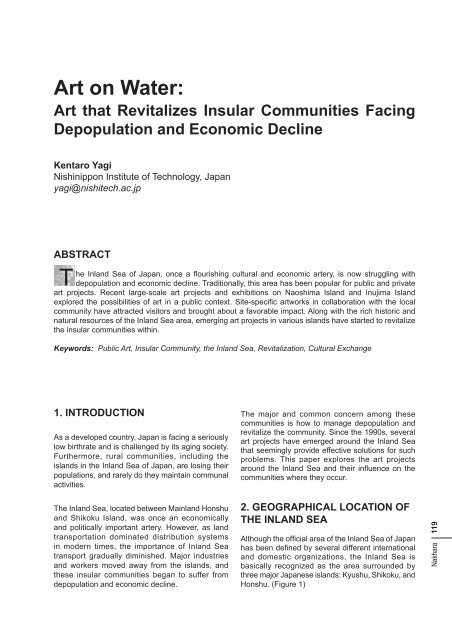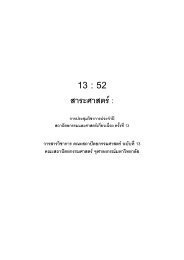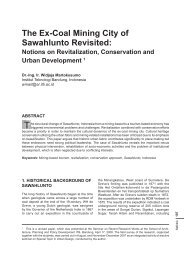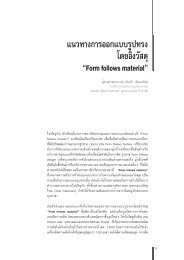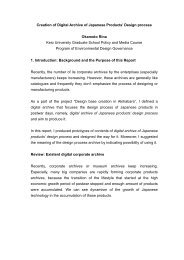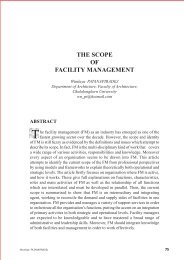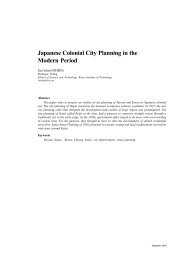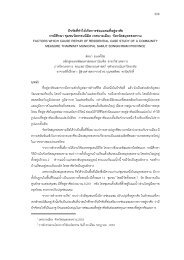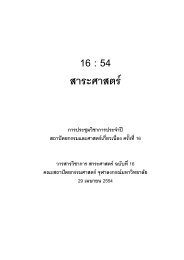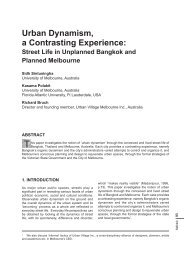Full Text PDF - Faculty of Architecture
Full Text PDF - Faculty of Architecture
Full Text PDF - Faculty of Architecture
You also want an ePaper? Increase the reach of your titles
YUMPU automatically turns print PDFs into web optimized ePapers that Google loves.
Art on Water:<br />
Art that Revitalizes Insular Communities Facing Depopulation and Economic Decline<br />
Art on Water:<br />
Art that Revitalizes Insular Communities Facing<br />
Depopulation and Economic Decline<br />
Kentaro Yagi<br />
Nishinippon Institute <strong>of</strong> Technology, Japan<br />
yagi@nishitech.ac.jp<br />
ABSTRACT<br />
T<br />
<br />
depopulation and economic decline. Traditionally, this area has been popular for public and private<br />
art projects. Recent large-scale art projects and exhibitions on Naoshima Island and Inujima Island<br />
<br />
community have attracted visitors and brought about a favorable impact. Along with the rich historic and<br />
natural resources <strong>of</strong> the Inland Sea area, emerging art projects in various islands have started to revitalize<br />
the insular communities within.<br />
Keywords: Public Art, Insular Community, the Inland Sea, Revitalization, Cultural Exchange<br />
1. INTRODUCTION<br />
As a developed country, Japan is facing a seriously<br />
low birthrate and is challenged by its aging society.<br />
Furthermore, rural communities, including the<br />
islands in the Inland Sea <strong>of</strong> Japan, are losing their<br />
populations, and rarely do they maintain communal<br />
activities.<br />
The major and common concern among these<br />
communities is how to manage depopulation and<br />
revitalize the community. Since the 1990s, several<br />
art projects have emerged around the Inland Sea<br />
that seemingly provide effective solutions for such<br />
problems. This paper explores the art projects<br />
<br />
communities where they occur.<br />
The Inland Sea, located between Mainland Honshu<br />
and Shikoku Island, was once an economically<br />
and politically important artery. However, as land<br />
transportation dominated distribution systems<br />
in modern times, the importance <strong>of</strong> Inland Sea<br />
transport gradually diminished. Major industries<br />
and workers moved away from the islands, and<br />
these insular communities began to suffer from<br />
depopulation and economic decline.<br />
2. GEOGRAPHICAL LOCATION OF<br />
THE INLAND SEA<br />
<br />
<br />
and domestic organizations, the Inland Sea is<br />
basically recognized as the area surrounded by<br />
three major Japanese islands: Kyushu, Shikoku, and<br />
Honshu. (Figure 1)<br />
Nakhara 119
Kentaro Yagi<br />
Figure 1:<br />
Location <strong>of</strong> the Inland Sea <strong>of</strong> Japan<br />
Nakhara 120<br />
national parks, was established in 1931; it has a total<br />
area <strong>of</strong> about 22,000 km 2 and 6,760 km <strong>of</strong> coastline.<br />
There are more than 700 islands within the park.<br />
It is known for its beautiful natural and agricultural<br />
landscape, and it traditionally provides natural<br />
resorts and tourist destinations for urban visitors.<br />
Many <strong>of</strong> the islands in this area are geographically<br />
close to major mainland cities—a condition that<br />
previously attracted many industries and their<br />
employees. Major industries <strong>of</strong> this area included<br />
shipbuilding, refining, salt and other chemical<br />
industries. However, many enterprises in these<br />
islands were discontinued, and very few shipbuilding<br />
islands. The declining economy has forced local<br />
communities to accept industrial waste from nearby<br />
unban areas, creating critical environmental issues<br />
and controversies.<br />
Three vehicular routes, one <strong>of</strong> which is shared with<br />
the railroad, bridged Honshu and Shikoku by 2000,<br />
connecting some <strong>of</strong> the major islands within the<br />
been expected to revitalize the regional economy;<br />
however, it seemed only to accelerate the exodus<br />
<strong>of</strong> local industries and population.<br />
3. ART IN A PUBLIC CONTEXT IN<br />
JAPAN<br />
Before exploring the art <strong>of</strong> the Inland Sea area, we<br />
Since public art in Japan has a unique background,<br />
it is essential to understand art in terms <strong>of</strong> Japanese<br />
culture, society, and administration.<br />
3.1 The Origin and Character <strong>of</strong><br />
Japanese Public Art<br />
In terms <strong>of</strong> its beginnings, Japan has a history <strong>of</strong> art<br />
in public places that is similar to that in the United<br />
States and many European and Asian countries.<br />
It began with the erection <strong>of</strong> religious monuments<br />
shared by the local community. Art in public spaces,<br />
in a modern sense, dates back to 1961, when Ube<br />
city, located near the west end <strong>of</strong> the Inland Sea,<br />
initiated its Sculpture in Public Places program<br />
(Figure 2). Ube city’s program even predates two<br />
famous U.S. public art programs: the Fine Arts<br />
Program <strong>of</strong> the U.S. General Services Administration<br />
(GSA), initiated in 1962 (later renamed in 1977 as<br />
the more popular Art-in-<strong>Architecture</strong> Program), and<br />
the Art in Public Places program <strong>of</strong> the National<br />
Endowment for the Arts (NEA), initiated in 1967.
Art on Water:<br />
Art that Revitalizes Insular Communities Facing Depopulation and Economic Decline<br />
Figure 2:<br />
Sculpture at Ube city, installed in the Tokiwa Park and facing the Inland Sea<br />
Following Ube city’s successful experiment,<br />
Japanese administration realized the potential <strong>of</strong><br />
public sculptures to help improve public amenities.<br />
Thereafter, the Sculptures in Public Places program<br />
proliferated to other Japanese municipalities; it<br />
integrated with outdoor sculpture competitions<br />
and/or exhibitions, typically on a biennial basis, to<br />
acquire artworks, thus following the model <strong>of</strong> Ube<br />
city’s pioneering program. Although Japanese art in<br />
public places may appear to be similar to American<br />
counterparts, it has a unique background and<br />
administrative intention.<br />
While the U.S. GSA’s public art program was<br />
clearly expected to “serve as a symbol <strong>of</strong> American<br />
democracy, creativity, and freedom” (Heartney, 2008,<br />
p.9) during the Cold War period, Japanese public<br />
art rarely expressed political intentions. Most <strong>of</strong> the<br />
programs in Japan during this period focused more<br />
on the educational aspects <strong>of</strong> sculptures exhibited<br />
in public spaces.<br />
Typically placed on a pedestal—as seen in museums<br />
and galleries—the majority <strong>of</strong> these sculptures<br />
were categorized as “site dominant”; such a piece<br />
<br />
[that] either rises out <strong>of</strong>, or is the occasion for, its<br />
‘ordinary’ circumstances” (Irwin, 1985, p.26). Since<br />
the administrators responsible for these programs<br />
<br />
they tended to consider artwork as minor additions to<br />
public spaces, rather than as cultural substances to<br />
be integrated to public spaces. As a result, in addition<br />
to abstract sculptures, quite a few representational<br />
sculptures, mostly <strong>of</strong> female nudes, have been<br />
installed in public places throughout Japan. This<br />
is extraordinary for Japanese public art, and it has<br />
sometimes triggered controversy.<br />
These public art programs initiated by municipal<br />
governments had a huge impact on public spaces in<br />
Japan. Although they were not always adequate for<br />
<br />
public art programs did not appear until the 1980s,<br />
when successful privately initiated public art projects<br />
emerged.<br />
Nakhara 121
Kentaro Yagi<br />
Nakhara 122<br />
3.2 Variations in Public Art<br />
Although Japan’s municipal public art program<br />
was initiated as part <strong>of</strong> an educational program,<br />
it delivered public art images similar to those in<br />
the United States or Europe. However, the lack <strong>of</strong><br />
consideration for context and public involvement<br />
raised controversy vis-à-vis the appropriateness <strong>of</strong><br />
the number and nature <strong>of</strong> the permanently installed<br />
sculptures that were funded with public monies. By<br />
the mid-1990s, more than 20,000 sculptures had<br />
been installed throughout Japan; some citizens,<br />
including feminist activists, started to criticize<br />
what they considered excessive public sculptures,<br />
<br />
“sculpture pollution” began to appear. The collapse<br />
<strong>of</strong> the Japanese asset price bubble and emerging<br />
criticism against art in public spaces brought a<br />
sudden cessation in the public art craze among<br />
Japanese municipalities, and the private sector came<br />
to play an important role.<br />
Following the successful Battery Park City<br />
development in New York, the Housing and Urban<br />
Development Corporation (HUD) started introducing<br />
artworks into their urban development projects<br />
to increase property values. Pioneering projects<br />
included Shinjuku i-Land and Faret Tachikawa,<br />
completed in 1995. Although the budgets for<br />
artworks were in line with the scale <strong>of</strong> these<br />
developments, the directors <strong>of</strong> these art projects<br />
took different approaches to integrating art and<br />
urban development. Shinjuku i-Land commissioned<br />
13 artworks from prominent artists and integrated<br />
<br />
Faret Tachikawa introduced over 100 artworks<br />
<strong>of</strong> various styles to mirror public diversity. The<br />
community, developers, and critics appreciated both<br />
<strong>of</strong> these projects and this integration <strong>of</strong> art with urban<br />
development became very common among largescale<br />
private urban developers in Japan.<br />
Art festivals were another category <strong>of</strong> art in public<br />
places, as initiated by the private sector, as well<br />
as temporary art installations, and sometimes also<br />
performance art, were <strong>of</strong>fered for fixed periods<br />
<strong>of</strong> time. Although these art festivals share some<br />
similarities with Ube city’s biennial competition/<br />
exhibition, artworks exhibited during festivals are<br />
usually withdrawn upon the festival’s completion. All<br />
<strong>of</strong> the early festivals initiated in the 1980s preferred<br />
rural areas, away from the limitations and restrictions<br />
<strong>of</strong> an urban context; in 1990, however, Museum City<br />
Tenjin <br />
urban art festival. Although art festivals—such as<br />
the Venice Biennale—have a long history in Europe,<br />
they were not as popular in Japan until the 1990s.<br />
Following the success <strong>of</strong> private art festivals around<br />
Japan, the public sector sought to support such<br />
art festivals once again. Administrators preferred<br />
art festivals to permanent installations, to preclude<br />
criticisms <strong>of</strong> the exhibited artworks; thus, publicly<br />
funded art festivals quickly became popular after<br />
2000. One such festival is the Echigo-Tsumari Art<br />
Triennial,<br />
directed by Fram Kitagawa, who had also directed<br />
the Faret Tachikawa art project. The Triennial attracts<br />
hundreds <strong>of</strong> thousand paying visitors, despite being<br />
held in the mountains, far from visitors’ metropolitan<br />
locales.<br />
4. ART AROUND THE INLAND SEA<br />
Along with tourists, the landscape <strong>of</strong> the Inland<br />
Sea has attracted many artists and art patrons.<br />
Japanese–American sculptor Isamu Noguchi, for<br />
example, established his studio in 1969 in Takamatsu<br />
city, overlooking the Inland Sea; it currently serves as<br />
the Isamu Noguchi Garden Museum Japan. Although<br />
this is a private enterprise and is therefore rarely<br />
described in the context <strong>of</strong> public art, Noguchi’s<br />
experiment implies that art has a very important role<br />
when integrated with the beauty <strong>of</strong> the Inland Sea<br />
landscape. Most importantly, the Garden Museum<br />
attracts many visitors from all over the world.<br />
Some municipalities in Japan initiated public art<br />
programs in the 1980s; Setoda town, Hiroshima (in<br />
Ikuchishima, which is now connected to mainland<br />
by bridges and is part <strong>of</strong> Onomichi city) was among<br />
them. In 1989, as part <strong>of</strong> the Hiroshima Exposition<br />
<strong>of</strong> Sea and Island, four public sculptures were<br />
dedicated at Sunset Beach. Two years later, town<br />
administrators decided to continue to install public<br />
sculptures under the name <strong>of</strong> Setoda Biennale; 17<br />
public sculptures were installed around the island<br />
before the Biennale was terminated in 1999. The<br />
typical variety followed after Ube city’s pioneering<br />
program was that commissioned sculptors were<br />
<br />
most <strong>of</strong> the artworks seem to “mesh” well with their<br />
surrounding landscape.<br />
Ushimado town (now part <strong>of</strong> Setouchi city) in<br />
Okayama hosted another variety <strong>of</strong> art project. A<br />
<br />
the Inland Sea funded the Ushimado International Art<br />
Festival, initiated in 1984 and held every year until
Art on Water:<br />
Art that Revitalizes Insular Communities Facing Depopulation and Economic Decline<br />
Figure 3:<br />
Locations <strong>of</strong> notable islands and municipalities around the Inland Sea<br />
1991. Although the festival itself was not very popular<br />
in its time, many renowned artists were invited to<br />
exhibit their work, and the festival is now considered<br />
a groundbreaking experiment. Administration <strong>of</strong> this<br />
festival by private patronage predates that <strong>of</strong> the<br />
Benesse Corporation and the Naoshima Fukutake<br />
Art Museum Foundation’s activities in the following<br />
decade, in Naoshima.<br />
5. NAOSHIMA<br />
5.1 Geography<br />
Naoshima is a relatively large Inland Sea island, 15<br />
km north <strong>of</strong> Takamatsu city. Naoshima comprises<br />
about 14 km 2 and has a population <strong>of</strong> 45,000. There<br />
are two regular surface service routes to Naoshima:<br />
20 min from Uno port near Okayama city, or 60 min<br />
from Takamatsu.<br />
Naoshima was once an important node <strong>of</strong> maritime<br />
<br />
manufacturing. A current notable industry there is the<br />
<br />
Naoshima is home to the disposal plant that handles<br />
large volumes <strong>of</strong> illegal industrial waste from nearby<br />
Teshima.<br />
5.2 Naoshima Contemporary Art<br />
Museum and Other Institutions<br />
In 1989, Fukutake Publishing Co. Ltd. (now the<br />
Benesse Corporation, which <strong>of</strong>fers educational<br />
materials for children and students) opened the<br />
Naoshima International Camp Site as a gathering<br />
place for children.<br />
Three years later, the Benesse House Museum—or,<br />
the Naoshima Contemporary Art Museum—designed<br />
by architect Tadao Ando opened in the southern part<br />
Nakhara 123
Kentaro Yagi<br />
Figure 4:<br />
Benesse House Museum, which exhibits Hiroshi<br />
Sugimito’s photography<br />
Figure 5:<br />
The Chichu Museum, almost completely buried<br />
underground<br />
Nakhara 124<br />
<strong>of</strong> Naoshima. The Museum has <strong>of</strong>fered various<br />
educational programs and exhibitions. Starting<br />
in 1994 with the exhibition Out <strong>of</strong> Bounds, the<br />
<br />
outside its walls. Benesse House is not only a<br />
Museum institution, but also the centerpiece <strong>of</strong><br />
Benesse Corporation’s community involvement<br />
activities. The Museum’s distinguished contemporary<br />
art collections and special exhibitions, along with<br />
the Museum building itself, attract many visitors<br />
(Figure 4).<br />
In Addition, the Chichu Art Museum opened in 2004,<br />
administered by the Naoshima Fukutake Art Museum<br />
Foundation. The Museum houses three permanent<br />
art-in-situ collections: Claude Monet, Walter De<br />
Maria, and James Turrell. Most <strong>of</strong> the building is<br />
buried underground, and thus is hardly noticeable<br />
from the outside (Figure 5). The Chichu Museum<br />
<br />
art exhibitions and the institutional gallery exhibitions<br />
<strong>of</strong> the Benesse House Museum.<br />
The Chichu Museum’s distinguished collections,<br />
prominent exhibitions, and art projects have attracted<br />
more and more visitors to the island, leading to the<br />
2006 addition <strong>of</strong> the “Park” and “Beach” buildings<br />
by Tadao Ando.<br />
5.3 Art House Project<br />
<br />
outside its walls, the Benesse House Museum took<br />
another step towards involving the community.<br />
Similar to other insular communities, Naoshima was<br />
suffering from depopulation and there were many<br />
vacant houses around the island.<br />
The Art House Project aimed both to attract<br />
commissioned artists and contribute to the local<br />
community. The Museum rented or purchased<br />
vacant houses and lots in the Honmura district<br />
<br />
exhibition spaces. Tatsuo Miyajima’s Kadoya was<br />
the first Art House Project, dedicated in 1998,<br />
followed by James Turrell and Tadao Ando’s<br />
Minamidera, Rei Naito’s Kinza, Hiroshi Sugimoto’s<br />
Go’o Shrine, Hiroshi Senju’s Ishibashi, Yoshihiro<br />
Suda’s Gokaisho, and Shinro Otake’s Haisha<br />
(Figure 6). There are currently seven Art Houses.<br />
Although called “Art Houses,” Turrell and Ando’s<br />
Minamidera is a reinterpretation <strong>of</strong> a former<br />
temple, and Sugimoto’s Go’o Shrine is actually a<br />
reconstruction <strong>of</strong> a historic shrine in the Honmura<br />
district. The Art House Project is not only a physical<br />
contribution that addresses housing vacancies<br />
around the island; it also supports the local<br />
community by providing a foundation for spiritual<br />
relief.<br />
The Art House Project is a privately funded<br />
project, but it does address the public issues <strong>of</strong> the<br />
community. As such, it is a great step forward with<br />
respect to private art patronage in Japan.
Art on Water:<br />
Art that Revitalizes Insular Communities Facing Depopulation and Economic Decline<br />
Figure 6:<br />
<br />
Naoshima<br />
5.4 Naoshima Standard Exhibition<br />
To celebrate its 10th anniversary, the Benesse House<br />
Museum hosted the Naoshima Standard exhibition in<br />
<br />
art installations in the residential district. Although<br />
the Standard exhibition looked somewhat similar to<br />
past art festivals, the Museum did not simply follow<br />
a preexisting scheme; it merged its experience with<br />
<br />
and was careful to involve the local community.<br />
Administrators secured exhibition spaces, not only<br />
in vacant houses and buildings, but also in streets,<br />
alleys, in-use houses, and shops <strong>of</strong> business<br />
(Figure 7). “The exhibition spaces were selected for<br />
their special character rather than being regarded as<br />
empty spaces” (Akimoto, 2002, p.221), and visitors<br />
enjoyed artworks in someone’s living room or behind<br />
shop counters. As a result, both artists and visitors<br />
became necessarily engaged with local residents.<br />
Such lines <strong>of</strong> communication had not been seen<br />
in former Benesse House Museum projects. The<br />
curator <strong>of</strong> this exhibition said that the relationship<br />
between the Museum and the community had been<br />
a “one-sided love affair that [had] been going on for<br />
ten years” (Akimoto, 2002, p.221), in that although<br />
it had established institutions on the island, they had<br />
not been community members prior to the exhibition.<br />
The Standard exhibition itself was a great success;<br />
Naoshima achieved popularity not only in the<br />
art world but also with the general public. It was<br />
<br />
in Naoshima: after a decade, they were finally<br />
recognized as a community member.<br />
In 2006 and 2007, they held a second exhibition,<br />
Standard 2. This exhibition took yet another step<br />
forward. This exhibition featured the dedication<br />
<strong>of</strong> the third phase <strong>of</strong> the Art House Project; more<br />
importantly, the exhibition was integrated with<br />
infrastructure improvements that had been funded<br />
by the municipal government. A new ferry terminal<br />
building was dedicated just prior to the opening<br />
Nakhara 125
Kentaro Yagi<br />
Figure 7:<br />
The Ochiai General Store installation by Shinro Otake,<br />
at a shop <strong>of</strong> business<br />
<strong>of</strong> Standard 2; architects SANAA, the Pritzker<br />
<strong>Architecture</strong> Prize Laureate <strong>of</strong> 2010, had designed<br />
the building. The exhibition provided an opportunity<br />
for private enterprise and local government to<br />
cooperate and improve the community.<br />
Having accumulated knowledge and experience,<br />
the Naoshima Fukutake Art Museum Foundation<br />
started planning for another ambitious project—this<br />
time, in Inujima.<br />
Inujima comprises a 0.54-km 2 area and a population<br />
<strong>of</strong> about 60.<br />
<br />
<br />
residents. After the local enterprise discontinued,<br />
the community started to decline. There are ruins <strong>of</strong><br />
<br />
plant, and the retaining walls. These picturesque<br />
ruins have attracted many movie and television<br />
directors as location sites.<br />
Nakhara 126<br />
6. INUJIMA<br />
6.1 Geography and Industrial<br />
History<br />
Inujima is a small island located 5 km south <strong>of</strong><br />
Hoden Port, on the southeast fringe <strong>of</strong> Okayama city.<br />
Although there used to be regular travel services<br />
from downtown Okayama, the only regular services<br />
connect the town to Hoden Port. There is also a<br />
reservation-based service from Naoshima. As the<br />
only inhabited island in Okayama city, there is a<br />
publicly run hotel and beach that attracts visitors<br />
during the summer season, but it does not garner<br />
enough business to maintain regular services from<br />
downtown.
Art on Water:<br />
Art that Revitalizes Insular Communities Facing Depopulation and Economic Decline<br />
6.2 Artists and Patronage<br />
<br />
artist Yukinori Yanagi’s encounter with the industrial<br />
<br />
gigantic brick-structure ruins near the shore suggest<br />
the impressive landscape <strong>of</strong> that time. Yanagi<br />
imagined reviving the environment and community,<br />
and named this, his private project, the Inujima Art<br />
Project.<br />
Initially, the artist was unsure <strong>of</strong> when and how the<br />
Inujima Art Project would be realized, but he believed<br />
he would see it within his lifetime. Things began to<br />
change after the artist gave a presentation <strong>of</strong> his<br />
vision for Inujima to Soichiro Fukutake, a long-time<br />
supporter <strong>of</strong> his art and president <strong>of</strong> the Naoshima<br />
Fukutake Art Museum Foundation. The artist and<br />
his project team gave presentations concerning the<br />
potential reuse <strong>of</strong> industrial ruins; later, Fukutake<br />
decided to purchase the Inujima property, including<br />
the industrial heritage site. This was a turning point<br />
for the Inujima Art Project in several ways. It is true<br />
<br />
the project, but at the same time, it meant that a<br />
project initiated by an artist’s dream and vision was<br />
now under the direction <strong>of</strong> Fukutake, the owner<br />
and general producer <strong>of</strong> the project, who sought<br />
to integrate the Inujima Art Project with other art<br />
projects in nearby islands.<br />
After long discussions, the producer brought<br />
Hiroshima-based architect Hiroshi Sambuichi into<br />
the project, and the new artist–architect team started<br />
to collaborate and create a new vision for Inujima.<br />
Under Fukutake’s direction, the push to renovate the<br />
<br />
Although the artist had envisioned the island project<br />
as an integration <strong>of</strong> his “artwork” with architecture<br />
and landscape, the director and administrators rather<br />
saw this project as an “architectural renovation” that<br />
<br />
the Chichu Museum <strong>of</strong> Naoshima.<br />
This project was fully funded through private<br />
patronage; since completion, it has been managed<br />
and administered by the Fukutake Naoshima Art<br />
Museum Foundation.<br />
<br />
Following the long artist–architect collaborative<br />
<br />
2008 with Seirensho<br />
Seirensho consists <strong>of</strong> four elements: 1) Industrial<br />
Heritage, 2) <strong>Architecture</strong>, 3) Environment System,<br />
and 4) Artwork. “Industrial Heritage” is the narrative<br />
site itself, with its historic structures remaining<br />
untouched. “<strong>Architecture</strong>,” designed by Hiroshi<br />
<br />
renovated to house “Artwork.” The “Environment<br />
<br />
uses biological and geological filters. “Artwork”<br />
here indicates new series <strong>of</strong> permanent installations<br />
<br />
Hero Dry-Cell. The “Artwork” here is more tightly<br />
integrated with the architectural structure than is the<br />
case at the Chichu Museum. The architect respected<br />
and carefully integrated the artist’s concepts and<br />
visions into the architectural renovations; thus, not<br />
<br />
the whole <strong>of</strong> the architectural renovation—and,<br />
furthermore, the Inujima Art Project itself—is an<br />
artwork derived from Yanagi’s artistic representation<br />
<strong>of</strong> the site and environment (Figure 8).<br />
Although the respective visions <strong>of</strong> the director, artist,<br />
and architect might have slightly differed, Seirensho<br />
is quite a successful artist–architect collaboration—a<br />
rarity in Japan. Following the project’s opening, the<br />
Inujima community gradually started to become<br />
revitalized. New cafés and shops, for example,<br />
have opened to meet the needs <strong>of</strong> rapidly increasing<br />
visitor volumes.<br />
6.4 Art House Project<br />
For the second phase <strong>of</strong> the Inujima Art Project,<br />
the director introduced an Art House Project that<br />
followed the Naoshima model. The artist was asked<br />
to collaborate with architect Kazuyo Sejima, and<br />
the project was to be dedicated at the Setouchi<br />
International Art Festival 2010.<br />
The second phase introduced a totally different<br />
approach. A curator joined the artist–architect<br />
<br />
and complicated. In addition, the commissioned<br />
architect showed much less interest in artwork and<br />
the history and environment <strong>of</strong> the site, compared<br />
to Sambuichi. As a result, the Art House Project<br />
in Inujima is more <strong>of</strong> an autonomous architectural<br />
project, independent from the context, environment,<br />
community, and artwork.<br />
Doubtless, the Project itself has attracted huge<br />
interest from both the art and architecture worlds.<br />
However, the Art House Project in Inujima would<br />
play a completely different role than the projects in<br />
Naoshima.<br />
Nakhara 127
Kentaro Yagi<br />
Figure 8:<br />
Seirensho greenhouse for passive solar air-conditioning and artwork installation<br />
<br />
Nakhara 128<br />
7. SETOUCHI INTERNATIONAL ART<br />
FESTIVAL 2010<br />
The Setouchi International Art Festival was held<br />
in the summer <strong>of</strong> 2010, under the main theme <strong>of</strong><br />
“Restoration <strong>of</strong> the Sea,” focusing on the eastern<br />
part <strong>of</strong> the Inland Sea; it was organized by Soichiro<br />
Fukutake as general producer, and Fram Kitagawa,<br />
director <strong>of</strong> Faret Tachikawa and the Echigo-Tsumari<br />
Art Triennial, as general director.<br />
This festival is a compilation <strong>of</strong> all the existing art<br />
enterprises <strong>of</strong> the Naoshima Fukutake Art Museum<br />
Foundation and local administrations, introducing<br />
new art and architectural projects on seven<br />
islands: Teshima, Oshima, Ogijima, Megijima, and<br />
Shodoshima, along with Naoshima and Inujima<br />
(Figure 9). Each island has a different historic<br />
background and character. New Art Projects include<br />
the collaborative work <strong>of</strong> artists and architects,<br />
as follows: artist Rei Naito and architect Ryue<br />
Nishizawa, artist Lee Ufan and architect Tadao<br />
Ando, artist Shinro Otake and design studio Graf,<br />
along with other art installations and events in the<br />
performing arts. All <strong>of</strong> the projects are meant to<br />
<br />
culture, community, and landscape.<br />
As the Setouchi International Art Festival is the<br />
<br />
Sea area, it represents Fukutake’s long-time vision<br />
<strong>of</strong> revitalizing Inland Sea culture and economy by<br />
means <strong>of</strong> art. At the same time, this is a public art<br />
festival in a maritime community, following the huge
Art on Water:<br />
Art that Revitalizes Insular Communities Facing Depopulation and Economic Decline<br />
Figure 9:<br />
Locations <strong>of</strong> seven islands hosting Setouchi International<br />
Art Festival 2010<br />
success <strong>of</strong> the Echigo-Tsumari Art Triennial held in<br />
the mountains.<br />
Even before the festival opened, its importance<br />
could already be seen in adjacent regions. For<br />
example, the former committee <strong>of</strong> the Ushimado<br />
International Art Festival decided to unpack the<br />
<br />
exhibit them to the public during the festival. Such<br />
interaction is in line with the very character <strong>of</strong> the<br />
Inland Sea, as an artery <strong>of</strong> cultural exchange.<br />
8. CONCLUSION<br />
Historically, the Inland Sea <strong>of</strong> Japan has been rich<br />
in natural resources, has beautiful landscapes, and<br />
above all, hosted a number <strong>of</strong> art projects under the<br />
patronage <strong>of</strong> both private and public administrations.<br />
The recent accumulation <strong>of</strong> art projects has attracted<br />
more and more visitors and artists throughout the<br />
region, and art projects have connected insular<br />
communities with urban residents.<br />
Even when well intended, art projects in small,<br />
insular communities <strong>of</strong> the Inland Sea can lead<br />
to a one-sided love for the community that is not<br />
<br />
self-centered. Although they are private enterprises,<br />
projects like Benesse House or the Inujima Art<br />
Projects could have wrought huge impacts on<br />
local economies, wreaking havoc on their host<br />
communities. In Naoshima, fortunately, Benesse<br />
House and the Naoshima Fukutake Art Museums<br />
Foundation have sought to carefully coordinate<br />
their relationships with the local community and<br />
keep projects within residential districts relatively<br />
small. We should also remember that even in that<br />
case, it took 10 years for them to become a part <strong>of</strong><br />
the community; the story <strong>of</strong> the “10-year one-sided<br />
<br />
inherent in large-scale private enterprises that<br />
operate community-oriented art projects in insular<br />
communities.<br />
As for Seirensho in Inujima, the artist and architect<br />
shared an attitude toward the history, community,<br />
Nakhara 129
Kentaro Yagi<br />
and environment <strong>of</strong> the area, guaranteeing respect<br />
for the local island characteristics. From this point<br />
<strong>of</strong> view, the Art House Project in Inujima—which<br />
took the opposite approach—will be an interesting<br />
experiment. Will the community accept the project?<br />
Or will they simply deny or ignore it? Only time<br />
will tell.<br />
The Art House Project and the Standard exhibition<br />
in Naoshima, along with Seirensho in Inujima,<br />
were unique landmarks <strong>of</strong> new genre public art in<br />
Japan. Although the projects were bankrolled by<br />
private funds, all the stakeholders—artists, curators,<br />
architects, and patrons—are interested in the public<br />
issues <strong>of</strong> the local community. They changed the<br />
community and local economy by attracting urban<br />
residents to the insular communities.<br />
Most <strong>of</strong> the art projects described in this paper are<br />
located in eastern parts <strong>of</strong> the Inland Sea; however,<br />
several projects are also emerging in western<br />
areas. Architect Toyo Ito is planning an architecture<br />
museum in Omishima, and artist Yukinori Yanagi has<br />
initiated another project on a nearby small island. By<br />
accumulating art and architectural institutions in this<br />
area, more and more artists, designers, and patrons<br />
will be attracted to the culture and landscape <strong>of</strong> the<br />
Inland Sea. Many metropolitan art fans follow and<br />
visit insular communities; the Setouchi International<br />
<br />
The Inland Sea <strong>of</strong> Japan, once known as a major<br />
artery <strong>of</strong> cultural and economic exchange, is being<br />
revived through art. Based on its relatively long<br />
historic background <strong>of</strong> arts support in the region—<br />
both private and public—existing public art, individual<br />
art practices, and emerging art and architectural<br />
projects around the Inland Sea are attracting visitors<br />
and local industry. Ultimately, they will improve those<br />
insular communities and return the area to its former<br />
glory as an artery <strong>of</strong> dynamic cultural exchange, <strong>of</strong><br />
urban and insular life alike.<br />
Raven A., ed. (1989) Art in the Public Interest, Ann Arbor,<br />
MI: UMI Research Press.<br />
Mitchell, W. J. T., ed. (1992) Art and the Public Sphere,<br />
Chicago: University <strong>of</strong> Chicago Press.<br />
Senie, H.F. and Webster, S. eds. (1992) Critical Issues in<br />
Public Art: Content, Context, and Controversy, New York:<br />
Icon Editions.<br />
Lacy S. ed. (1995) Mapping the Terrain: New Genre<br />
Public Art, Seattle: Bay Press.<br />
Deutsche, R. (1996) Evictions: Art and Spatial Politics,<br />
Cambridge, MA: The MIT Press.<br />
Miles, M. (1997) Art Space and the City: Public Art and<br />
Urban Futures, London: Routledge.<br />
Echigo-Tsumari Art Triennial 2000 Executive<br />
Committee, ed. (2001) Echigo-Tsumari Art Triennial<br />
2000, Tokyo: Gendaikikakushitsu Publishers.<br />
Takeda, N. and Yagi, K. (2001) Management <strong>of</strong> Aesthetic<br />
Intentions in Urban Design, Journal <strong>of</strong> Korean Institute<br />
<strong>of</strong> Landscape <strong>Architecture</strong>, International Edition, No. 1,<br />
pp.167–175.<br />
Akimoto Y. and Henmi Y. eds. (2002) The Standard,<br />
Okayama: Naoshima Contemporary Art Museum.<br />
Heartney, E. (2008) Introduction, GSA Art and<br />
<strong>Architecture</strong>: Selected Artworks 1997–2008, Washington,<br />
D.C.: Art in <strong>Architecture</strong> Program.<br />
Nakhara 130<br />
REFERENCES<br />
Harney, A. L., ed. (1981) Art in Public Places, Washington<br />
D.C.: Partners for Livable Places.<br />
Irwin, R. (1985) Being and Circumstance: Notes Towards<br />
a Conditional Art, Larkspur Landing, CA: The Lapis Press.
Notes on the Contributors<br />
Prathiwi Putri was born in Jakarta, 1981. After training as an architect in Institut Teknologi Bandung<br />
(graduated 2004), she has been mainly involved in post-disaster reconstruction works with a communitybased<br />
and integrated approach in Aceh and Java. Prathiwi got a Master <strong>of</strong> Human Settlements (KU Leuven)<br />
degree in 2008 and currently is working on a doctoral research sponsored by Vlaamse Interuniversitaire<br />
Raad (Belgium) under the supervision <strong>of</strong> ASRO, KU Leuven. ‘Urban community dynamics and the making<br />
<strong>of</strong> place’ is her main interest.<br />
Aryani Sari Rahmanti is born in Bandung, the city <strong>of</strong> Indische architecture, which inspired her to attend<br />
an architecture education at Institut Teknologi Bandung. Prior to her accomplishment <strong>of</strong> a Master <strong>of</strong> Human<br />
Settlements at KU Leuven, Belgium, in 2009, she was fully engaged with major projects as a design<br />
<br />
Urbanism and Strategic Planning (MaUSP) at the same university in Belgium while being partially involved<br />
in urban research.<br />
Basauli Umar Lubis has been a lecturer at the Department <strong>of</strong> <strong>Architecture</strong>, Institut Teknologi Bandung<br />
(ITB) since 1979. He received his master degree in architecture from ITB in 1985 and his Ph.D. in Urban<br />
Planning from Royal Melbourne Institute <strong>of</strong> Technology (RMIT) in 2002. He has carried out many studies<br />
related to the traditional waterfront settlements including in Agats Papua, and Banjarmasin and Pontianak<br />
in Borneo.<br />
Widjaja Martokusumo (1966) graduated in 1991 from the Department <strong>of</strong> <strong>Architecture</strong>, Institut Teknologi<br />
Bandung (ITB) and he was awarded a Doktor-Ingenieur (Dr.-Ing.) degree in urban planning and design from<br />
the Fachbereich Stadt-/ Landschaftsplanung, Universität Gesamthochschule Kassel, Germany in 1999. He<br />
was a visiting assistant pr<strong>of</strong>essor and lecturer at the Fakultät Architektur, Fachchschule Erfurt in Winter<br />
Semester 2008/2009, and is an associate pr<strong>of</strong>essor in the Architectural Design Research Division (ADRD),<br />
at the School <strong>of</strong> <strong>Architecture</strong>, Planning and Policy Development ITB. Currently, he is the head <strong>of</strong> Graduate<br />
Programmes in <strong>Architecture</strong> and Urban Design. He teaches architecture and urban design, urban heritage<br />
<br />
Indonesia. His articles have been published in Jahrbuch Stadterneuerung TU Berlin (2000 and 2002),<br />
The Indonesian Town Revisited, edited by P.J.M. Nas, (2002), Jurnal Perencanaan Wilayah dan Kota ITB<br />
(2006, 2008), and Journal <strong>of</strong> Southeast Asian <strong>Architecture</strong> (JSEAA), National University Singapore (2008).<br />
Assistant Pr<strong>of</strong>essor Claire Napawan joined UC Davis’ Department <strong>of</strong> Environmental Design in fall<br />
2009. Her research focuses on urban public open spaces and their role within the evolving city. In light<br />
<strong>of</strong> economic, social, and environmental changes within urban development, including population growth<br />
and climate change, Claire has an interest in investigating the roles in which landscapes might adapt to<br />
provide ever-increasing productive and infrastructural programs to the global city. Claire holds a bachelors<br />
degree in architecture from Washington University in St. Louis and a masters in landscape architecture<br />
from Harvard’s Graduate School <strong>of</strong> Design.<br />
Nakhara 131
Pei-Chun Wen received two Masters degrees in both <strong>Architecture</strong> and Urbanism from the European<br />
postgraduate Masters in Urbanism (TU Delft, KU Leuven, IUAV Venice, UBC Barcelona), and National<br />
Cheng-Kung University (NCKU Taiwan). She is currently a Ph.D. student at the Department <strong>of</strong> <strong>Architecture</strong>,<br />
Urbanism and Planning at the University <strong>of</strong> Leuven (Belgium), researching on issues related to water and<br />
urbanity. She also teaches architecture design studios at NCKU.<br />
Sidh Sintusingha received his Ph.D. in 2005 from the <strong>Faculty</strong> <strong>of</strong> <strong>Architecture</strong>, Building and Planning, The<br />
University <strong>of</strong> Melbourne before joining their landscape architecture program as an academic. Through his<br />
research, teaching and pr<strong>of</strong>essional activities, he has contributed to the study <strong>of</strong>: urban sprawl and cultures<br />
<br />
processes in both developed and developing cities. He has widely presented and published in these areas<br />
both locally and internationally.<br />
Kasama Polakit received her Ph.D. from the University <strong>of</strong> Melbourne, Australia in 2004. She is an Assistant<br />
Pr<strong>of</strong>essor in the Department <strong>of</strong> Urban and Regional Planning, Florida Atlantic University, Ft Lauderdale,<br />
USA. She has experience in teaching architecture and urban design in Thailand, Australia, and the US. Her<br />
research interests include the relationship between the built environment and the development <strong>of</strong> social<br />
and cultural capital and Asian urbanism.<br />
Richard Bruch is director and founding member <strong>of</strong> Urban Village Melbourne Inc, a community based social<br />
enterprise, whose members explore sustainability challenges through collaborative and interdisciplinary<br />
practices. He has a background in economics and landscape architecture which he uses to develop deep<br />
local knowledge <strong>of</strong> inner-urban Melbourne. His interests are in integrating digital and parametric design<br />
techniques alongside landscape architectural, urban design, community development, community cultural<br />
development and bureaucratic (policy) processes.<br />
Swinal Samant completed her Diploma in <strong>Architecture</strong> in India, her Masters Degree from University <strong>of</strong><br />
<br />
practice experience in India and the UK between 1993 and 2001, Swinal joined as a lecturer at the<br />
Department <strong>of</strong> <strong>Architecture</strong> and Built Environment at the University <strong>of</strong> Nottingham in 2001. Her teaching<br />
spans across Undergraduate and Postgraduate programs through which she fully contributes to the ethos<br />
<strong>of</strong> holistic sustainable design and seamless integration <strong>of</strong> environmental design strategies in the built<br />
environment. Her research on Environmental Sustainability focuses on Urban Design, undertaken primarily<br />
through the medium <strong>of</strong> ‘Waterfront Regeneration’; and Building Science conducted largely through the<br />
‘Investigations <strong>of</strong> Daylighting in Atrium Buildings’. This research has made a considerable impact within<br />
<br />
journals and conference proceedings, serving on editorial boards, invited speaking at regional, national<br />
and international events, and funding bids.<br />
Kentaro Yagi, associate pr<strong>of</strong>essor at Nishinippon Institute <strong>of</strong> Technology, has been teaching architecture<br />
and design for 8 years. He has obtained doctoral degree from Kobe University, after studying architecture<br />
<br />
culture, and sustainable rural community design. He is also practicing in architecture, landscape, graphic<br />
and environmental design.<br />
Nakhara 132<br />
Fransje Hooimeijer is researcher at TNO and at the University <strong>of</strong> Technology Delft, department <strong>of</strong><br />
<br />
urban development and the technology <strong>of</strong> water management in the Netherlands. She has interest and<br />
expertise in urban construction related to the physical geographical circumstances <strong>of</strong> the location. At TNO<br />
and at the TU she is expanding her research into urban climate studying urban typology in relation to<br />
climate change. She published: The form and function <strong>of</strong> water in the city (2008) and History <strong>of</strong> urban water<br />
in Japan’ in: Urban water in Japan (2008).
Dr. Krishne Gowda is a Pr<strong>of</strong>essor <strong>of</strong> Urban and Regional Planning at the Institute <strong>of</strong> Development Studies<br />
at the University <strong>of</strong> Mysore, India. He has published more than 40 research papers in both national and<br />
international journals and also attended more than 50 conferences/seminars/workshops. He has guided<br />
eight Ph.D. students and 7 more are working at present. One <strong>of</strong> his researchs paper received a highly<br />
commended award from Emerald Publication, UK.<br />
M. V. Sridhara, a retired Pr<strong>of</strong>essor from the University <strong>of</strong> Mysore , is generally interested in public affairs.<br />
He is given to write to newspapers on mattes <strong>of</strong> social, economic, political and educational interest. In<br />
particular, he has written many papers on urban planning, environment and related issues along with Pr<strong>of</strong>.<br />
Krishne Gowda <strong>of</strong> the Institute <strong>of</strong> Development Studies, Mysore. He has reviewed many papers centering<br />
on water management and related social issues like public participation and empowerment. In brief, he is<br />
an intellectual with a sense <strong>of</strong> social concern.<br />
Mr. Mahendra B. is an additional Director in the Bangalore Metroopolitan Regional Development Authority<br />
in Bangalore . He has worked at different level at the Town Planning Department in Karnataka State in India<br />
and is also involved many planning projects in Karnataka.<br />
Nakhara 133


